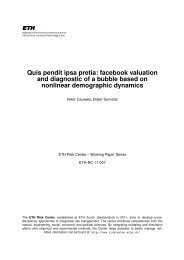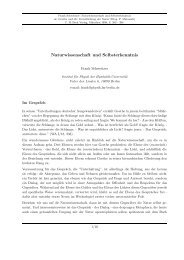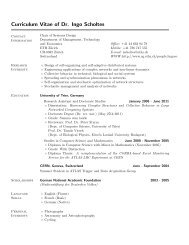Using Laboratory Experiments to Study Law and Crime - Chair of ...
Using Laboratory Experiments to Study Law and Crime - Chair of ...
Using Laboratory Experiments to Study Law and Crime - Chair of ...
You also want an ePaper? Increase the reach of your titles
YUMPU automatically turns print PDFs into web optimized ePapers that Google loves.
ththThe 19 <strong>and</strong> 20 centuries produced breakthroughs in physics, chemistry, <strong>and</strong> thebiological sciences. <strong>Labora<strong>to</strong>ry</strong> research played an important role in the rapid advances made inthese fields. Can labora<strong>to</strong>ry research also contribute <strong>to</strong> progress in the social sciences? Can itcontribute <strong>to</strong> progress in law <strong>and</strong> criminology?Open any social science methods textbook <strong>and</strong> you will see evaluations <strong>of</strong> the strengths<strong>and</strong> weaknesses <strong>of</strong> different methods. These evaluations typically include a claim that labora<strong>to</strong>ryexperiments are high in internal validity <strong>and</strong> low in external validity. This claim sometimes isfollowed by the conclusion that, in practice, labora<strong>to</strong>ry experiments are <strong>of</strong> little use in the socialsciences. But this conclusion is premature. <strong>Labora<strong>to</strong>ry</strong> experiments can be used <strong>to</strong> develop <strong>and</strong>test not just theories about the physical world, but also about the social world. By relying onmultiple methods – including labora<strong>to</strong>ry experiments – we can increase our knowledge.To make this argument, we begin by discussing what labora<strong>to</strong>ry experiments can <strong>and</strong>cannot do. We then describe three issues in the criminological <strong>and</strong> legal literature – whyviolence is higher in the southern United States than in the North, the relation between theseverity <strong>of</strong> punishment <strong>and</strong> crime, <strong>and</strong> the expressive effects <strong>of</strong> law. We describe the relevantdata from labora<strong>to</strong>ry experiments <strong>and</strong> discuss how these data complement those gained throughother methods.WHAT LABORATORY EXPERIMENTS CAN AND CANNOT DOHis<strong>to</strong>rically, criminologists have most commonly relied on surveys, data from <strong>of</strong>ficialrecords <strong>and</strong> other sources <strong>of</strong> quantitative data, along with ethnographic studies (for someexceptions see Steffensmeier <strong>and</strong> Terry 1975). Recently, field experiments have garneredattention because <strong>of</strong> their strengths in determining causality (see, for example Farring<strong>to</strong>n <strong>and</strong>Welsh 2005 for a review <strong>of</strong> the last two decades; see also Welsh <strong>and</strong> Farring<strong>to</strong>n 2001). An entirejournal (the Journal <strong>of</strong> Experimental Criminology) is now devoted <strong>to</strong> reporting experimental2







